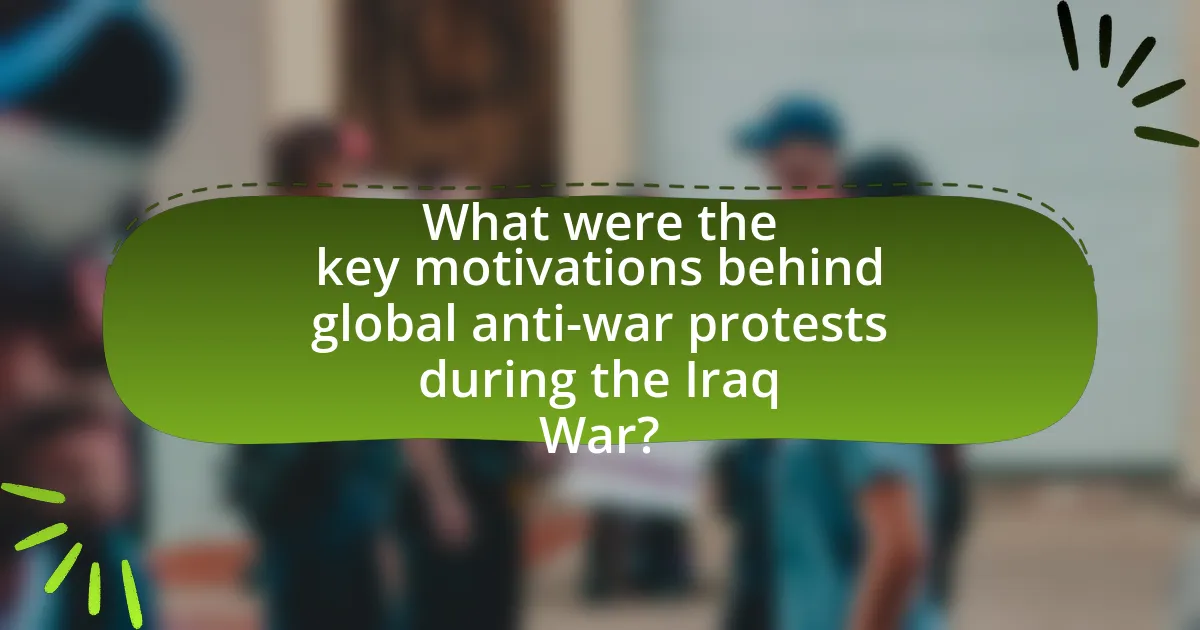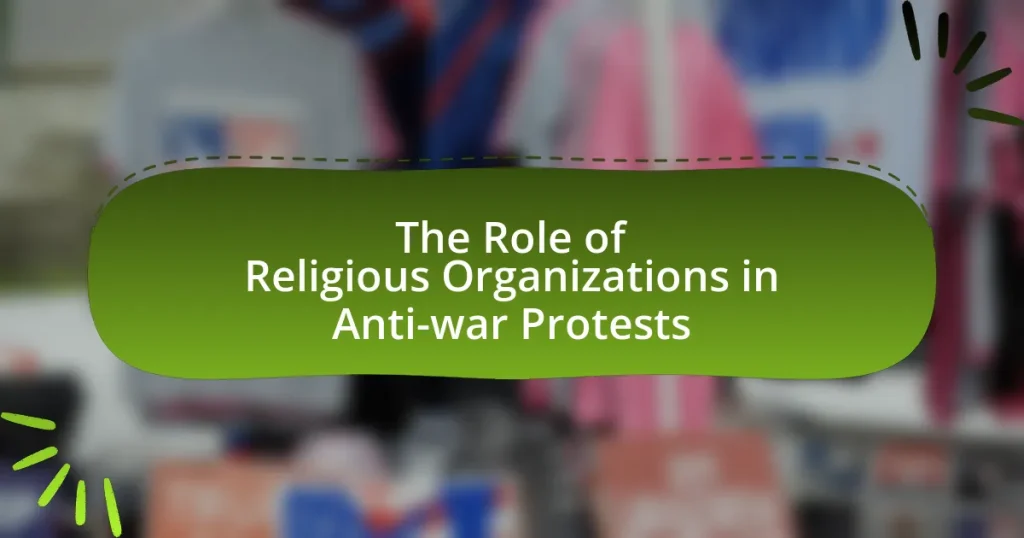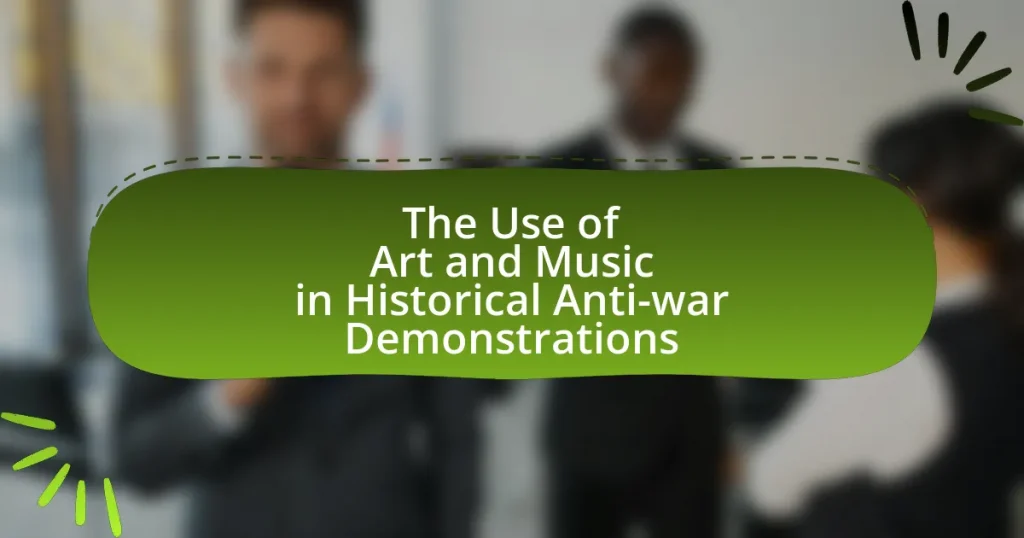The article provides a comparative study of global anti-war protests during the Iraq War, highlighting key motivations such as opposition to the war’s legitimacy, concerns over civilian casualties, and perceived ulterior motives like oil interests. It examines how public opinion and media coverage shaped the protests, influencing government policies and public discourse. The article also details the characteristics of protests in various countries, including the United States and Europe, and analyzes the outcomes of these movements, including legislative changes and shifts in public sentiment regarding military intervention. Additionally, it identifies best practices and strategies for future movements based on the experiences of the Iraq War protests.

What were the key motivations behind global anti-war protests during the Iraq War?
The key motivations behind global anti-war protests during the Iraq War included opposition to the perceived illegitimacy of the war, concerns over civilian casualties, and the belief that the conflict was driven by ulterior motives such as oil interests. Many protesters argued that the invasion lacked a United Nations mandate, which fueled claims of illegality. For instance, a significant global protest on February 15, 2003, saw millions rallying in cities worldwide, emphasizing widespread public dissent against the war. Additionally, reports indicated that the war resulted in substantial civilian casualties, with estimates suggesting tens of thousands of Iraqi deaths, further galvanizing public outrage and mobilizing protests across various nations.
How did public opinion shape the protests?
Public opinion significantly shaped the protests against the Iraq War by mobilizing large segments of the population who opposed military intervention. Surveys conducted prior to the war indicated that a majority of citizens in various countries, including the United States and the United Kingdom, expressed skepticism about the justification for the invasion, with polls showing that around 60% of Americans opposed the war at its onset. This widespread dissent translated into organized demonstrations, as seen in the February 15, 2003 protests, which drew millions globally, making it one of the largest coordinated anti-war demonstrations in history. The alignment of public sentiment with anti-war activism pressured political leaders to reconsider their positions and policies, illustrating the direct impact of collective opinion on the scale and intensity of the protests.
What role did media coverage play in influencing public sentiment?
Media coverage significantly shaped public sentiment regarding the Iraq War by framing narratives that influenced perceptions and attitudes. For instance, extensive reporting on civilian casualties and anti-war protests heightened public awareness and concern, leading to increased opposition to the war. A study by the Pew Research Center in 2003 found that media portrayal of the conflict, particularly images of destruction and suffering, correlated with a decline in support for military action among the American public. This illustrates how media coverage not only informed but also swayed public opinion, making it a crucial factor in the dynamics of anti-war sentiment during that period.
How did government policies affect public perception of the war?
Government policies significantly shaped public perception of the war by influencing media narratives and public discourse. For instance, the U.S. government’s emphasis on national security and the justification of military action through claims of weapons of mass destruction created a framework that initially garnered public support. However, as evidence emerged contradicting these claims, such as the 2004 Senate Intelligence Committee report revealing the lack of WMDs, public sentiment shifted towards skepticism and opposition. This shift was further amplified by policies that restricted media access to the battlefield, which limited independent reporting and contributed to growing distrust among the populace. Consequently, government policies not only framed the initial justification for the war but also played a crucial role in altering public perception as the realities of the conflict became clearer.
What were the primary goals of the anti-war movements?
The primary goals of the anti-war movements during the Iraq War were to oppose military intervention, advocate for peace, and promote the protection of human rights. These movements sought to mobilize public opinion against the war, emphasizing the belief that military action would lead to unnecessary loss of life and destabilization of the region. For instance, large-scale protests, such as those organized by the International ANSWER Coalition, highlighted the moral and ethical implications of the war, arguing that it was unjust and based on misleading information regarding weapons of mass destruction. Additionally, the movements aimed to influence policymakers to pursue diplomatic solutions rather than military ones, reflecting a widespread desire for a peaceful resolution to conflicts.
How did different groups articulate their demands?
Different groups articulated their demands through organized protests, public statements, and media campaigns. For instance, peace organizations like the International ANSWER Coalition emphasized the need for immediate withdrawal of troops and highlighted the humanitarian impact of the war through rallies and educational events. Grassroots movements, such as those led by students and labor unions, often focused on specific local issues, such as the economic costs of the war, using slogans and visual imagery to convey their messages effectively. Additionally, prominent figures and celebrities utilized their platforms to raise awareness and mobilize support, further amplifying the demands for peace and justice. These varied approaches collectively underscored a unified opposition to the war, demonstrating the diverse strategies employed by different groups to express their concerns and demands.
What impact did these goals have on the protests’ strategies?
The goals of the anti-war protests significantly influenced their strategies by prioritizing non-violent civil disobedience and broad coalition-building. These objectives aimed to attract diverse participants and maintain public support, leading organizers to adopt tactics such as peaceful marches, sit-ins, and the use of social media for mobilization. For instance, the large-scale protests in cities like London and New York utilized these strategies to effectively convey their message against the Iraq War, resulting in some of the largest demonstrations in history, with millions participating globally. This strategic focus on inclusivity and non-violence helped to sustain momentum and visibility for the anti-war movement, ultimately shaping public discourse around the conflict.

Which countries experienced significant anti-war protests during the Iraq War?
Countries that experienced significant anti-war protests during the Iraq War include the United States, the United Kingdom, Spain, Italy, and Australia. In the United States, millions participated in protests, particularly in 2003, with events organized by groups like ANSWER and the United for Peace and Justice coalition. The United Kingdom saw large demonstrations, notably the February 15, 2003 protest, which attracted over a million participants in London. Spain’s protests were significant, especially after the 2004 Madrid train bombings, which were linked to the Iraq War. Italy also witnessed widespread protests, with major demonstrations occurring in cities like Rome. Australia had notable protests, particularly in 2003, where thousands rallied against the war. These protests were characterized by their scale and the involvement of diverse groups advocating for peace and opposition to military intervention.
What were the characteristics of protests in the United States?
Protests in the United States during the Iraq War were characterized by large-scale mobilization, diverse participation, and a strong emphasis on anti-war messaging. These protests often featured organized marches, rallies, and sit-ins, with significant involvement from various groups, including peace organizations, labor unions, and student associations. For instance, the largest protest occurred on February 15, 2003, when millions participated globally, with over 1 million demonstrators in cities like New York and San Francisco. The protests were marked by a variety of tactics, including the use of signs, chants, and performances to convey opposition to the war, reflecting a broad coalition of voices united against military intervention.
How did grassroots organizations mobilize support in the U.S.?
Grassroots organizations mobilized support in the U.S. by leveraging community engagement, social media, and coalition-building strategies. These organizations utilized local networks to organize protests, distribute information, and foster a sense of collective identity among participants. For instance, groups like MoveOn.org and the American Friends Service Committee effectively used online platforms to reach a broader audience, facilitating rapid mobilization for events such as the large-scale protests in 2003 against the Iraq War. Additionally, grassroots organizations often collaborated with other activist groups, enhancing their reach and impact through shared resources and coordinated efforts, which was evident in the diverse coalitions formed during the anti-war movement.
What were the major events that defined the U.S. anti-war movement?
The major events that defined the U.S. anti-war movement include the Vietnam War protests, the 2003 Iraq War demonstrations, and the establishment of organizations like ANSWER and MoveOn.org. The Vietnam War protests, particularly the Kent State shootings in 1970, galvanized public opposition, leading to widespread demonstrations across college campuses and cities. In 2003, millions participated in protests against the Iraq War, with significant events occurring on February 15, when over 1 million people marched in New York City alone. Organizations such as ANSWER, founded in 2001, played a crucial role in mobilizing protests, while MoveOn.org utilized online platforms to organize and spread anti-war messages. These events collectively shaped public discourse and influenced U.S. foreign policy.
How did protests in Europe differ from those in the U.S.?
Protests in Europe during the Iraq War were generally larger and more widespread compared to those in the U.S., reflecting a broader public opposition to the war. For instance, the February 15, 2003 protests saw millions marching in cities like London, Paris, and Rome, while the largest U.S. protests, such as those in New York and San Francisco, attracted hundreds of thousands. Additionally, European protests often included a wider range of political groups and were more likely to be organized by coalitions of labor unions, NGOs, and political parties, whereas U.S. protests were predominantly organized by anti-war activist groups. This difference in scale and organization highlights the varying levels of public sentiment and political engagement regarding the Iraq War in Europe compared to the United States.
What were the unique cultural and political contexts influencing European protests?
European protests during the Iraq War were influenced by a combination of historical anti-war sentiments, national identities, and political opposition to U.S. foreign policy. The legacy of previous conflicts, such as the Vietnam War, fostered a strong anti-militaristic culture in many European countries, particularly in the UK and France. Additionally, widespread discontent with the perceived unilateralism of the U.S. government, especially in the lead-up to the invasion of Iraq in 2003, galvanized public opinion against the war. For instance, over a million people marched in London on February 15, 2003, reflecting a significant cultural mobilization against the war. Political parties and civil society organizations also played crucial roles, with many leftist groups organizing protests to challenge the government’s stance, thereby creating a unique political landscape that emphasized solidarity and collective action against perceived imperialism.
How did the scale and organization of protests vary across European countries?
The scale and organization of protests during the Iraq War varied significantly across European countries, reflecting differing political climates and public sentiments. For instance, in the United Kingdom, protests were large-scale and highly organized, with over two million people participating in the February 2003 demonstration in London, making it one of the largest protests in British history. In contrast, Germany saw substantial protests as well, with hundreds of thousands gathering in cities like Berlin and Hamburg, but the organization was more decentralized, with various groups coordinating independently. France experienced a mix of large protests, particularly in Paris, but faced challenges in organization due to competing political agendas among leftist groups. These variations highlight how national contexts influenced both the scale of participation and the methods of organization, with some countries exhibiting more unified movements while others displayed fragmented efforts.

What were the outcomes of the global anti-war protests during the Iraq War?
The global anti-war protests during the Iraq War resulted in significant public awareness and mobilization against the war, influencing political discourse in various countries. These protests, which included millions of participants worldwide, demonstrated widespread opposition to the invasion, leading to increased scrutiny of government policies and decisions regarding military intervention. For instance, the largest protest occurred on February 15, 2003, when an estimated 10 million people participated globally, marking it as one of the largest coordinated protests in history. The protests did not prevent the war but contributed to a sustained anti-war sentiment and shaped future political movements and discussions surrounding military actions.
How did the protests influence government policies and decisions?
Protests significantly influenced government policies and decisions during the Iraq War by compelling leaders to reconsider military strategies and engage in diplomatic efforts. For instance, widespread demonstrations in countries like the United States and the United Kingdom led to increased public pressure on governments to justify their actions and seek alternative solutions. In the UK, the massive anti-war protests in 2003, which saw over a million participants, prompted Prime Minister Tony Blair to face intense scrutiny and ultimately affected his political standing, leading to a shift in public discourse regarding military intervention. Similarly, in the U.S., the protests contributed to a growing anti-war sentiment that influenced the 2006 midterm elections, resulting in a Democratic majority that pushed for a reevaluation of U.S. involvement in Iraq. These examples illustrate how grassroots movements can directly impact governmental decision-making processes and policy directions.
What legislative changes were prompted by the protests?
The protests against the Iraq War prompted significant legislative changes in various countries, notably the introduction of laws aimed at increasing government accountability and transparency regarding military engagements. For instance, in the United States, the protests led to the establishment of the War Powers Resolution amendments, which sought to limit the president’s ability to engage in military action without congressional approval. Additionally, in the United Kingdom, the protests influenced the Labour government to implement the Iraq Inquiry, which aimed to investigate the decision-making process leading to the war. These legislative changes were direct responses to public dissent and aimed at addressing concerns over governmental authority in military matters.
How did protests affect public discourse on military intervention?
Protests significantly influenced public discourse on military intervention by amplifying anti-war sentiments and fostering critical debate. The widespread demonstrations against the Iraq War in 2003, for instance, mobilized millions globally, leading to increased media coverage and public discussions questioning the justification for military action. According to a Pew Research Center study, public opposition to the Iraq War rose from 29% in 2002 to 63% by 2004, illustrating how protests shifted perceptions and encouraged a more skeptical view of government narratives regarding military interventions. This shift in public opinion was further reflected in political discourse, as lawmakers began to address constituents’ concerns about the war, ultimately impacting policy discussions and decisions.
What lessons can be learned from the global anti-war protests?
Global anti-war protests demonstrate the power of collective action in influencing public opinion and policy. These protests, particularly during the Iraq War, highlighted the effectiveness of grassroots mobilization, as seen in the millions who participated worldwide, which pressured governments to reconsider military interventions. Historical data shows that large-scale protests can lead to significant political outcomes; for instance, the widespread demonstrations in 2003 contributed to a decline in public support for the war in several countries, including the United States and the United Kingdom. This indicates that organized dissent can serve as a critical mechanism for democratic engagement and accountability.
How can future movements leverage the strategies used during the Iraq War protests?
Future movements can leverage the strategies used during the Iraq War protests by employing mass mobilization, coalition-building, and effective use of social media. Mass mobilization was evident in the Iraq War protests, where millions participated globally, demonstrating the power of collective action to influence public opinion and policy. Coalition-building among diverse groups, including peace organizations, labor unions, and student groups, created a unified front that amplified their message and increased visibility. Additionally, the effective use of social media platforms allowed for rapid dissemination of information, organization of events, and engagement with a broader audience, as seen in the widespread online campaigns that accompanied the protests. These strategies collectively contributed to raising awareness and exerting pressure on decision-makers, which future movements can replicate to enhance their impact.
What best practices emerged from the organization and execution of these protests?
Best practices that emerged from the organization and execution of anti-war protests during the Iraq War include effective use of social media for mobilization, strategic coalition-building among diverse groups, and clear messaging that resonated with a broad audience. Social media platforms like Facebook and Twitter facilitated rapid dissemination of information, allowing organizers to reach large numbers of participants quickly, as evidenced by the millions who participated in protests globally on February 15, 2003. Coalition-building among various organizations, including labor unions, student groups, and peace organizations, enhanced the protests’ visibility and impact, demonstrating that a united front can amplify voices. Additionally, crafting clear and compelling messages, such as “Not in Our Name,” helped to unify participants and articulate the protests’ objectives, making them more relatable and engaging for the public.



